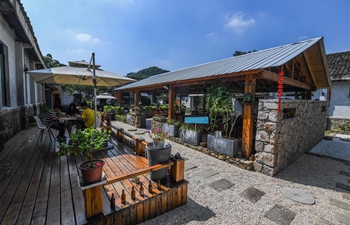JINAN, Aug. 7 (Xinhua) -- Two ancient tombs with delicate stone reliefs were discovered in Jinan, capital of east China's Shandong Province, local archaeological authorities said Wednesday.
Located in Jinan's Jiyang District, the tombs are believed to date back to the Han Dynasty (206 B.C.-A.D. 220), according to the city's institute of archaeology. They were found when local residents dredged a pond at the end of 2018.
After nearly four months of archaeological excavation work, a total of almost 60 stone reliefs and more than 90 portraits were unearthed in the tombs. They vividly depict scenes of daily life in ancient times, in addittion to several portraits of goat heads, which are commonly seen in tombs with stone reliefs in the region.
The approximately 20-meter-long and 15-meter-wide tomb is said to be the largest double-passage tombs with stone reliefs from the Han Dynasty ever found in Jinan.
Besides abundant stone reliefs, the tombs contained a great number and variety of potteries, porcelains, bone objects, stoneware and bronze coins, as well as animal bones, said local archaeologists.
Though the tombs had been disturbed, the whole structure is well preserved, providing new archaeological material for the study of funeral customs in the Han Dynasty, said Chen Yongting, leader of the excavation team.
Stone reliefs were an important building component of palaces, ancestral temples and tombs in the Han Dynasty.

















